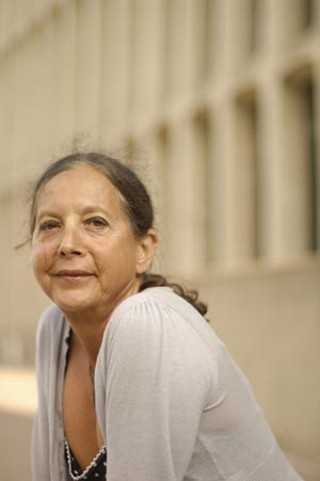Making It Happen
The 2007 class of the Austin Arts Hall of Fame
By Robert Faires, Fri., June 1, 2007
James Armstrong and Larry Connelly
Separately, these two gentlemen are both committed patrons of the arts, providing invaluable aid for artists and organizations across Austin. Together, they are more like a force of nature for culture, one whose winds of support blow through every major arts entity in the city. Go to the UT College of Fine Arts, and you'll see where Armstrong contributed major support to the residency of internationally renowned string quartets. Go to the Zachary Scott Theatre Center, and you'll see Connelly taking a very active role in Red, Hot & Soul, the theatre's annual gala fundraiser. Go to Ballet Austin, and you'll see Armstrong's and Connelly's names adorning one of the studios in the new Butler Dance Education Center opening this fall. (It's also where the two co-chaired – with Austin Arts Hall of Famers Sarah and Ernest Butler – the company's golden anniversary gala this season.) And of course, go to Austin Lyric Opera, and you'll see Armstrong's name on the Community Music School, the first such school in the country run by an opera company and a sign of the profound commitment to education by both men. A seven-figure gift to the Long Center. Serving on the board of advisors for the Austin Museum of Art and the Heritage Society of Austin. And extending their hands beyond the arts to health and social-justice causes. Connelly and Armstrong are present in all corners of the community and not merely present but engaged. And Austin is richer for it.
Sally Jacques

Don't seek Sally Jacques among the haunts of other dancers and choreographers. Mirror-lined studios and concert-hall stages are not where her heart – or art – lives. For the two decades and more that she's been creating dance in our city, Jacques has set her work in specific sites around the city, incorporating the architecture; naturally occurring qualities of light, texture, sound, and physical activity; and the character of the site, its purpose in the community (or absence of purpose), and its condition into her performance. Sometimes her sites are indoors – cavernous industrial spaces such as warehouses and airplane hangars with room for epic movement – but more often, they are outside: the shores of Town Lake, an abandoned swimming pool off Riverside, a dumping ground for cement mixers in South Austin, the Texas Capitol, Barton Springs Pool, and, most spectacularly last year, the abandoned shell of the Intel building. Through Jacques' artistry and the collaborative efforts of many of the city's most gifted dancers, musicians, and designers, those sites are transformed into magnificent spaces of beauty. In addition to being a pioneer in site-specific work, Jacques has always been one of our city's most politically engaged artists, creating work that drew attention to issues such as homelessness (The 64 Beds Project), rape (Invasion), and the first Gulf War (Inside the Heart). And for more than a decade, her meditative performance Bodycount kept us mindful of the losses we've suffered from AIDS on World AIDS Day. She has also taught movement to senior citizens, the disabled, and at-risk teenagers and has traveled internationally in support of peace and women's movements. In 1987 she was given the Susan B. Anthony Award for Peace. In 2003, she was named YWCA Woman of the Year for the Arts.
Emily Little

Joni Mitchell tagged pretty much all of us when she famously sang, "Don't it always seem to go that you don't know what you've got till it's gone?" But it's safe to say she wasn't talking about Emily Little. This Austinite has always understood what's special about her hometown and has spent a quarter of a century working to preserve and restore historical pieces of our town before they're lost to the ravages of time or disinterest. An architect of uncommon common sense and sensitivity, Little has played an integral role in the revitalization of the city's iconic moonlight towers, the 18-acre Texas State Cemetery, the J.P. Schneider Store (currently home to Lamberts), and the Arnold Bakery (now Shoehorn Design), as well as older homes too numerous to list. But Little is not only about looking backward. She has her eyes cast squarely toward the future in terms of her commitment to cost-effective, energy-efficient, and environmentally sound building and site design. A great friend of the arts in Austin, she provides support to numerous cultural groups across the city and occasionally her professional skills, as with the Tré Arenz Rememberance Fountain on the hike-and-bike trail, which Little designed in honor of the late artist. Her honors are legion and include the 1993 Texas Society of Architects Award for Young Professional Achievement and, for her work on Parque Zaragoza Recreation Center, a 1996 TSA Honor Award for Architecture and a 1997 American Institute of Architects Austin Chapter Design Award.
Harold McMillan

Some fight to save the scene that was. Some fight to make the scene that will be. Harold McMillan does both. Even as he steadfastly documents and preserves part of the city's rich musical heritage through the 18-year-old Austin Blues Family Tree Project (which contains dozens of hours of interviews with Eastside musicians and 150 hours of performance recordings), McMillan is constantly working out ways to promote the artists enlivening Austin's music, literary, and visual-arts scenes right now. The Austin Jazz and Arts Festival, the Clarksville Jazz Sessions, DiverseArts Little Gallery, Austin Downtown Arts Magazine, the Women in Jazz Concert Series, East End Fourth Fridays, the word/jazz improvised music and spoken-word series, the African American History Month Concert Series, the Austin Acoustic Music Festival – all were generated by this social-work-grad-turned-cultural-impresario, chiefly through his DiverseArts Production Group, a nonprofit that he founded in 1994 to provide access and exposure to traditions derived from African-American culture. Combined with an activist bent that has involved McMillan with the Austin Music Commission, the Texas Commission on the Arts, the Austin Community College Commercial Music advisory board, and the International Association for Jazz Education, it seems this publisher/editor/writer/musician/concert promoter/record producer/gallery owner/cultural historian has his fingers in more pies than he has digits to stick in them. Few people in Austin have labored as hard and persistently for the city's African-American artists as McMillan, and whenever he's dealt a setback – as by the 2005 Guadalupe Cultural Arts Center fire that destroyed the DiverseArts office space and gallery – he manages to come back stronger.
Ishmael Soto

When the Austin visual-arts scene underwent a seismic shift in the 1950s, thanks to the influx of forward-thinking Lone Star modernists hired to teach art at the University of Texas, Ishmael Soto was there, and the aspiring artist – then a student at UT – took what he absorbed from the likes of Everett Spruce, Kelly Fearing, Ralph White, Michael Frary, and Charles Umlauf and began making his own art: bronze figurines and ceramic dishware and copper abstracted teapots and more, which, a half-century on, have shaped a remarkable body of work, as seen most powerfully in the recent retrospective mounted by Mexic-Arte Museum. Soto came of age at a time when Latino artists were not as prominent on the scene as they've come to be in more recent decades, so he served as an inspiration in that regard. He has also shared his knowledge and skill with the generations that have risen behind him, teaching art, first at his old alma mater, then for the past 20 years at Austin Community College. That he is still in the studio, at the potter's wheel and the kiln, still prodigiously turning out new vases and plates and sculptures after a full five decades, is testament to Soto's burning desire to create.
Dan Welcher

Sad to say, but when it comes to orchestral music, most folks expect all the good composers to be, well, dead. Dan Welcher knows that isn't the case, and for as long as he's been in Austin (coming up on three decades), he's been as impassioned a champion for contemporary composers as the city has had. Upon landing here in 1978, the Rochester, N.Y., native and trained bassoonist founded the New Music Ensemble in the UT School of Music and has served as its director ever since, leading the ensemble each year through a half-dozen concerts of chamber music composed chiefly within the past two decades. Frequently, the works are by nationally prominent composers – some of whom come to UT and participate in the school's Visiting Composers Series – but Welcher also makes a point of programming original works by his composition students and composers on the UT faculty. Naturally, one of those faculty members is Welcher himself, who has more than 80 compositions to his credit in virtually any genre you care to name: concerto, symphony, art song, opera, chamber music, piano solo, and so on. He has composed works for the Honolulu Symphony Orchestra, the Handel and Haydn Society of Boston, the Boston Pops Orchestra, the West Point Band, the Utah Symphony Orchestra, the Dallas Symphony Orchestra, to name a few, and has had more than 50 orchestras perform his music. And when he isn't composing or on the podium (he spent 10 years as assistant conductor of the Austin Symphony Orchestra), you can catch him over the airwaves, on his weekly radio series, Knowing the Score (Sunday, 8pm, on KMFA 89.5FM).
Suzan Zeder

If all the term "children's theatre" conjures in your mind are treacly moral lessons hammered home by cardboard characters who talk down to kids, then you haven't been blessed by the plays of Suzan Zeder. In trailblazing works such as Mother Hicks, Doors, Time Again in Oz, and Step on a Crack, this internationally acclaimed playwright has managed to take issues of genuine concern for children – divorce, remarriage, just growing older – and address them on the child's level, with a deep respect for the child's intelligence and a clear-eyed presentation of the hardships and fears that might trouble him or her. And make no mistake, her works are dramas. Zeder may be writing for younger audiences, but she believes they are no less deserving of a tightly crafted play than adults, and she labors to give them dramatically engaging works. Which may explain why she has been honored four times with the Distinguished Play Award from the American Alliance for Theatre and Education and why her plays are produced constantly throughout the country and overseas. One admirer wrote that "when it comes to challenging, innovative theatre for young audiences, Suzan Zeder is the standard against which others are measured." Zeder's work with and advocacy for playwrights is another powerful standard she's set. For a decade, she's headed the playwriting program at UT, working with writers in both the Department of Theatre & Dance and the Michener Center for Writers, and she's been a principal force behind the biennial David Mark Cohen New Works Festival, which gives students throughout the department an opportunity to create and present original work. A member of the College of Fellows of the American Theatre, Zeder has chaired the Playwright's Fellowship panel for the National Endowment for the Arts and Theatre Communications Group. ![]()









